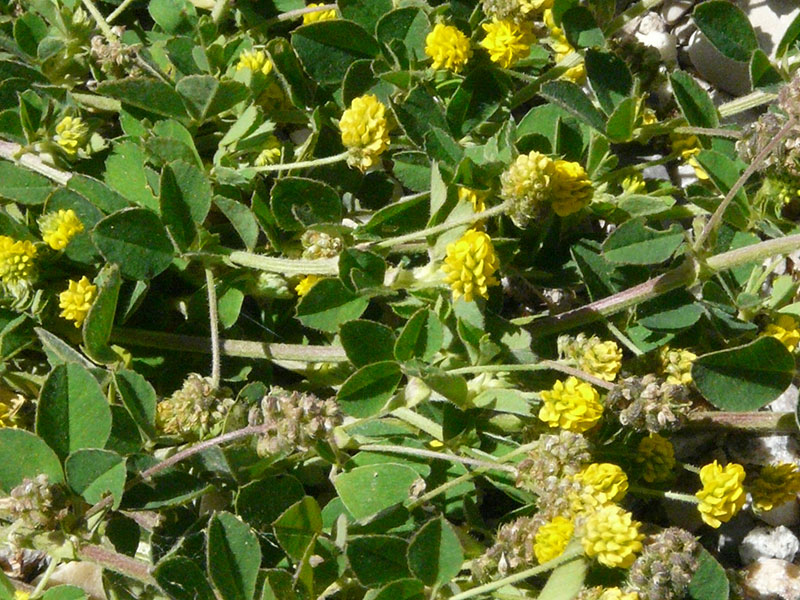Medicago lupulina / black medic
- prostrate, long creeping stems
- compound leaves with 3 small, rounded leaflets
- teeny yellow flowers in very small button-like clusters
- disturbed areas with compacted soil – roadsides & wastelands
Also known as: black medick, nonesuch, hop clover, black hay, blackweed, English trefoil, hop trefoil, and yellow trefoil (some of these names are also used for other plants)
Black medic is a common, prostrate, broadleaf weed found in dry, sunny areas, especially waste ground and along roadsides. It’s easily recognized by its numerous, small yellow blossoms and its long stems creeping out across the pavement.
In the Valley, black medic is an annual (perhaps perennial in warmer areas) and a pioneer species, generally restricted to bare soils. Its ability to colonize compacted soil is probably why you can find it on the gravel berms of roads. Because it is not shade tolerant and is quite low, it doesn’t compete well with other plants so it is seldom a major weed. Besides the compacted soil habitat, its trick is that as a legume capable of nitrogen fixation, it can colonize soils low in that nutrient, soils excluding other species.
Like the true clovers and its close relative, alfalfa, black medic has three (small) oval leaflets carried on a short petiole. Although you may never have reason to look this closely, the center leaflet is on a short stalk while the side leaflets are sessile. The leaflets are hairy (sometimes), sort of toothed toward the tip, and end in a short point.
The black medic inflorescence is composed of teeny yellow flowers grouped in tight bunches (compact racemes). These racemes are borne in the leaf axils, each rounded to slightly elongated cluster having 10-50 flowers. Even with that many flowers, however, clusters are very small (not much more than 1/4 inch).
The individual flowers have a pea-like structure with an upper standard and a lower keel; the former is larger than the latter but they are all too small for a cellphone photo to show. If you aren’t careful, you’ll start carrying a hand lens to see things like this.
The fruit is a small (1.5-3 mm) pod containing only a single seed. It doesn’t open upon maturation, but hardens and turns black when ripe (hence the name, black medic). The seeds can persist in the seed bank for years. Seeding is the only way the species spreads, but nevertheless, it can form large colonies.
Although easily pulled (despite having a relatively long taproot), it is a significant enough weed in lawns and gardens that many websites have pages devoted to getting rid of it.

